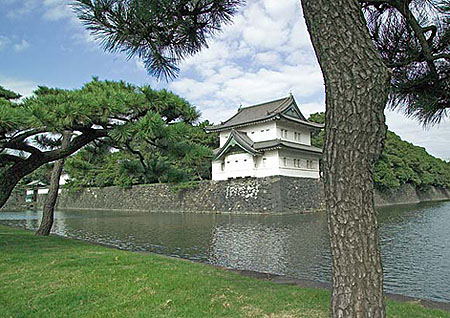HIS 112
Unit 4: East Asia

Edo Castle (now the Imperial Palace in Tokyo)
was built in 1457 and during the Edo period, or the Tokugawa Shogunate, served as the
capital of Japan. The castle suffered much damage
over the years from fires, earthquakes and war, and then during World
War II, U.S. bombing raids destroyed more. This is a photo of moat, wall and
building; photo courtesy Wikipedia Commons.
 What you
must do in this unit
What you
must do in this unit
- Read chapter 21 in the textbook (chapter 20 in the Edgar text).
- Check the course notes on East Asia and Japan.
- Study the Questions to Consider and the Key Terms for the unit.
- Post (or respond) your thoughts/ideas about this unit's reading and assignment in the Blackboard online discussion forum. Do not post your assignment there.
What you can do in this unit
- Read the decrees on the Seclusion of Japan (if you are going to submit the optional Japan paragraph).
- Submit the Optional Japan paragraph
- Listen to some further information about this unit's course subject
as a mp3 file.
You can also read the information as
a txt file.
Some videos that you can watch for this unit
Extra Credit Options
- Take the short 5-point quiz for chapter 21. Log into Blackboard and look under "Chapter Quizzes." You have five minutes to complete each quiz (multiple-choice questions).
- Some of the best portrayals/recreations of Tokugawa Japan can be found in the films of
Akira Kurosawa (1910-1999), the great Japanese director. I can heartily recommend his Seven Samurai (1954) or Kagemusha (1980) as capturing the complexities of early modern
Japan. Consider watching either of these films for extra
credit. In a one-page paper, comment upon the historical accuracy
of the film that you have watched for a maximum of 50 points.
- For
extra credit of a maximum of 25 points, in a long paragraph consider a
comparison of way of the samurai (see Tsunetomo Yamamoto, Hagakure,
which is sometimes called the "way of the samurai") with the way of the
medieval knight (for example in the Song of Roland). Please be sure to cite your sources. (You may consider writing a longer essay
for more extra credit, but only if the second page is very good.)
- For extra credit of a maximum of 25 points, read K'ang-Hsi: The Sacred Edicts (1670) and write a paragraph in which you comment upon the philosophy of government expressed there.
- For extra credit of a maximum of 25 points, read Honda Toshiaki, A Secret
Plan for Government (1798), and write a paragraph in which you comment upon the
philosophy of government expressed there. (If you want even more
extra credit, consider comparing Honda Toshiaki and K'ang-Hsi.)
- For 10 points maximum extra credit, answer the Japan paragraph study sheet questions.
- For extra credit, please suggest a
relevant website for this unit of the course. Send the title of the site, the url and a
brief explanation why you find the information interesting and applicable to
the material being studied this unit.
|

